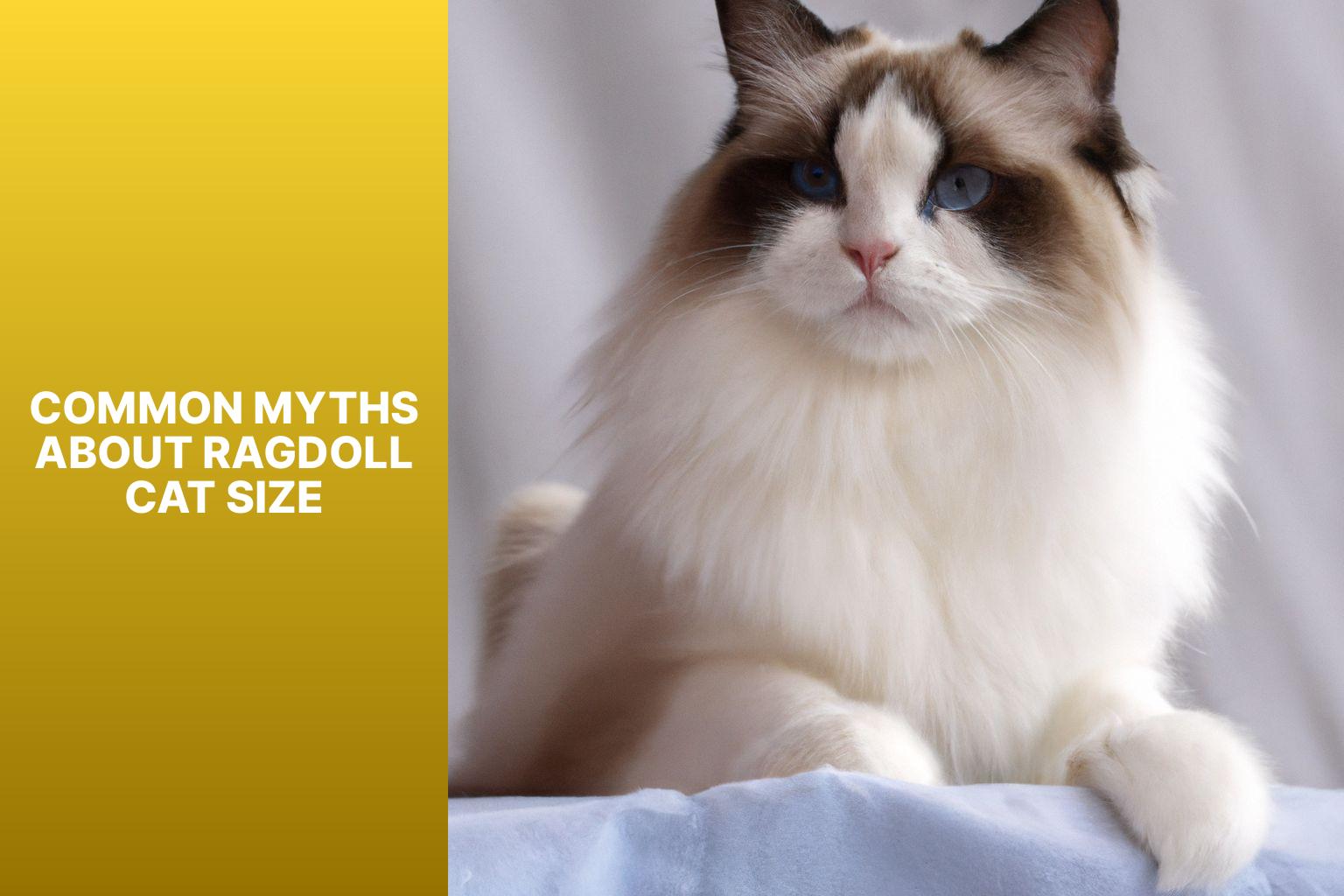Ragdoll cats are known for their beautiful appearance and gentle temperament. If you’re considering getting a Ragdoll cat or already have one, you may be curious about how large they can grow. Various factors contribute to the size of Ragdoll cats, and understanding these factors can help you better understand the growth potential of this breed.
Physical Characteristics of Ragdoll Cats:
Ragdoll cats typically have a muscular body with a broad chest and strong legs. They are a large-breed cat known for their large, expressive blue eyes that add to their overall charm. Their silky, semi-long fur comes in a variety of colors and patterns, further enhancing their appeal.
Factors That Influence the Size of Ragdoll Cats:
1. Genetics: Like most living beings, genetics play a significant role in determining the size of Ragdoll cats. The size of their parents and the lineage they come from can influence how big they grow.
2. Gender: In general, male Ragdolls tend to be larger and heavier than females. This is not a strict rule, as individual variation exists within the breed.
3. Nutrition and Diet: Providing your Ragdoll cat with a balanced diet that meets their nutritional needs is crucial for their growth and development. Proper nutrition ensures they receive the necessary nutrients for optimal growth.
4. Overall Health and Well-being: Ragdoll cats that receive proper veterinary care, regular exercise, and a stress-free environment are more likely to reach their full size potential.
Typical Size Range of Adult Ragdoll Cats:
On average, adult Ragdoll cats can weigh between 10 to 20 pounds (4.5 to 9 kilograms), with males being larger than females. It’s important to note that there can be variations within this range, depending on the factors mentioned above.
Comparing Ragdoll Cats to Other Breeds:
When compared to other cat breeds, Ragdolls are indeed larger in size. Their substantial build and muscular physique make them bigger than many other domestic cat breeds.
How to Help Ragdoll Cats Reach Their Full Size Potential:
To ensure your Ragdoll cat reaches their full size potential, provide them with a balanced diet, regular exercise, and proper veterinary care. Engaging them in play activities and providing them with adequate mental stimulation can also contribute to their growth and overall well-being.
Common Myths About Ragdoll Cat Size:
There are various myths surrounding the size of Ragdoll cats, including claims that they can grow to the size of small dogs or that they continue growing throughout their entire lives. It’s important to separate fact from fiction and rely on accurate information when it comes to understanding the growth patterns of Ragdoll cats.
By considering these factors and understanding the typical size range of Ragdoll cats, you can have a better idea of what to expect as your furry friend grows and matures.
Key takeaway:
- Ragdoll cats can reach a large size: Ragdolls are known for their big size, with males often weighing between 15-20 pounds and females slightly smaller.
- Genetics play a role in size: The size of a Ragdoll cat can be influenced by its genes, with certain lines bred for larger sizes.
- Diet and nutrition contribute to size: Providing a balanced and nutritious diet can help Ragdoll cats reach their full size potential.
Physical Characteristics of Ragdoll Cats
The physical characteristics of Ragdoll cats contribute to their charm and appeal as pets. Ragdolls, being larger than other cat breeds, have a sturdy and muscular build, with broad chests and strong limbs. Their bodies are well-proportioned and balanced. The medium to long-length fur of Ragdolls is soft, silky, and non-matting. Ragdolls come in various colors and patterns, including seal, blue, chocolate, lilac, bi-color, and colorpoint. Their most distinctive feature is their striking blue eyes, which can vary in shade.
With their sweet and gentle expression, large round eyes, and full cheeks, Ragdolls have an endearing appearance. Their medium-sized ears are slightly rounded at the tips. In terms of temperament, Ragdolls are known for their calm and affectionate nature. They are often compared to dogs because they enjoy following their owners around and love being held and cuddled.
If you decide to bring a Ragdoll cat into your home, make sure to provide them with enough space to move comfortably due to their larger size. Regular grooming is necessary to maintain their beautiful coat. Ragdoll cats are visually stunning and make wonderful companions.
Factors That Influence the Size of Ragdoll Cats
When it comes to the size of Ragdoll cats, there are several factors at play. From genetics to gender, nutrition to overall health, each aspect contributes to their ultimate size. Let’s dive into these factors and uncover how they influence the size of these adorable feline companions. Get ready to learn fascinating insights, backed by reliable sources, about what determines the size of Ragdoll cats.
Genetics
The size of Ragdoll cats is significantly influenced by their genetics. Various genes and genetic factors play a role in determining their size. The size of Ragdolls is also affected by the sizes of their parents. Breeders intentionally choose larger breeding pairs in order to produce larger cats.
In addition to genetics, certain genetic characteristics such as bone structure and body composition can also impact their size. It is important to note that genetics alone do not exclusively determine the size of Ragdolls. Other factors like gender, nutrition, and overall health also have an influence.
Typically, male Ragdolls tend to be larger due to their muscular build. Providing proper nutrition and a well-balanced diet is crucial for their healthy growth. To maximize the potential size of Ragdolls, it is necessary to provide them with appropriate care and support. This includes offering them a high-quality diet, ample living space, and regular exercise.
It is important to consider other factors such as gender, nutrition, and health in order for Ragdolls to reach their full size potential.
Gender
Gender plays a role in determining the size of Ragdoll cats. Generally, male Ragdolls are larger and heavier than females. On average, males weigh between 10 to 20 pounds (4.5-9 kilograms), while females weigh between 8 to 15 pounds (3.6-6.8 kilograms). It’s important to note that these are general ranges, and individual Ragdoll cats may vary. Various factors, such as genetics, nutrition, and overall health, can also influence their size and weight. Providing a balanced diet, proper healthcare, and a stimulating environment can help Ragdoll cats reach their full size potential and maintain their well-being.
Nutrition and Diet
Nutrition and diet play a significant role in the growth and development of ragdoll cats. There are several key factors to consider when it comes to their nutrition:
– Protein: For muscle growth and overall health, ragdoll cats require a diet that is rich in high-quality protein. When choosing cat food, look for options that have a specific animal protein source, such as chicken or fish, as the primary ingredient. This ensures that your cat gets the protein they need.
– Essential nutrients: It’s important to make sure that your ragdoll cat’s diet includes all essential nutrients, including vitamins and minerals. These nutrients are crucial for supporting bodily functions and maintaining healthy organ function. To meet these requirements, a balanced diet that incorporates both wet and dry food is recommended.
– Hydration: Proper hydration is vital for ragdoll cats. Ensure that you always provide fresh and clean water for your cat to drink. Some cats may prefer running water, so using a cat water fountain can be beneficial in encouraging them to stay hydrated.
– Portion control: Ragdoll cats have a tendency to overeat, which can lead to obesity. Therefore, it’s important to measure their food portions and avoid free-feeding. Follow the feeding guidelines provided by the cat food manufacturer and adjust the portions based on your cat’s activity level and body condition.
By providing a balanced and nutritious diet, you can optimize the growth and overall well-being of your beloved ragdoll cat.
Cats have historically evolved as obligate carnivores, meaning they primarily require animal protein in their diet. The process of domestication has allowed humans to provide commercially prepared cat food that meets their nutritional needs. It is still crucial to meet the specific nutritional requirements of cat breeds like ragdoll cats to support their unique growth and development.
Overall Health and Well-being
Ragdoll cats require proper care for their overall health and well-being. Maintaining their overall health and well-being entails regular veterinary check-ups, annual vaccinations, and preventive treatments.
Providing a balanced and nutritious diet, including high-quality cat food, is essential for their physical health. To prevent obesity and keep them active, it is crucial to ensure regular exercise and mental stimulation. Interactive play sessions, scratching posts, and toys are great ways to satisfy their natural instincts.
Regular grooming, such as brushing their fur, plays a vital role in keeping their coat clean and healthy. Creating a safe and stress-free environment with access to fresh water and a comfortable resting place significantly contributes to their overall well-being.
Prioritizing the overall health and well-being of Ragdoll cats is paramount in ensuring they lead a happy and fulfilling life.
Comparing Ragdoll Cats to Other Breeds
The table below compares Ragdoll cats to other popular cat breeds:
| Breed | Size | Temperament | Lifespan |
|---|---|---|---|
| Ragdoll | Large | Gentle, affectionate | 12-17 years |
| Maine Coon | Large | Friendly, playful | 12-15 years |
| Siamese | Medium | Vocal, intelligent | 12-15 years |
| Persian | Medium to large | Calm, reserved | 12-16 years |
| British Shorthair | Medium to large | Easygoing, independent | 12-17 years |
| Abyssinian | Small to medium | Energetic, adventurous | 9-15 years |
| Sphynx | Small to medium | Curious, affectionate | 8-14 years |
Ragdoll cats are large and have a gentle, affectionate temperament. They are one of the largest domestic cat breeds, weighing between 10 and 20 pounds. Comparing Ragdolls to other breeds, Maine Coon cats are also large but have a more playful and friendly nature. Siamese cats are medium-sized with a vocal and intelligent personality. Persian cats have a calm and reserved nature and can be medium to large in size. British Shorthair cats are similar in size to Ragdolls and are easygoing and independent. Abyssinian cats are smaller in size, but they are energetic and love to explore. Sphynx cats, despite being hairless, are small to medium-sized, curious, and very affectionate. The lifespan of these breeds ranges from 8 to 17 years, with Ragdolls having an average lifespan of 12 to 17 years.
How to Help Ragdoll Cats Reach Their Full Size Potential
To assist Ragdoll cats in reaching their complete size potential, here are the necessary steps:
1. Provide a well-balanced and nutritious cat food designed specifically for their needs. This will ensure they receive all the essential nutrients required for healthy growth.
2. Engage your Ragdoll cat in playtime activities using interactive toys and regular play sessions. This will encourage physical activity, maintain a healthy weight, and develop strong muscles.
3. Make sure to give your Ragdoll cat ample space to move freely. This can be achieved by providing climbing structures and scratching posts that encourage exercise and stretching.
4. Schedule regular visits to the vet to monitor your cat’s growth and overall health. This will also provide guidance on the appropriate diet and specific needs.
It is important to note that Ragdoll cats are a slow-maturing breed, and it may take up to three or four years for them to reach their full size and weight potential. Patience and consistent care are crucial in helping them develop into their majestic size.
Common Myths About Ragdoll Cat Size
Photo Credits: Www.Catcornerblog.Com by Sean Roberts
There are common myths about Ragdoll cat size that need to be debunked. First and foremost, Ragdolls are not the largest cat breeds. In fact, the Maine Coon and Norwegian Forest cats tend to be typically larger. It’s important to understand that Ragdolls come in a variety of sizes. Some may be smaller and more petite, while others may be larger and more robust.
Although it’s commonly believed that male cats are larger than females, this is not always the case with Ragdolls. Size can vary within the breed, and individual cats may not always conform to gender-based size expectations.
Another myth is that Ragdolls reach their full size by the age of 3-4 years. While they may gain weight or become more muscular after that, their skeletal structure is fully developed by that age.
It’s important to note that a Ragdoll’s size does not determine its personality traits. Regardless of size, Ragdolls are known for their docile and gentle nature.
Some Facts About How Big Do Ragdoll Cats Get:
- ✅ Ragdoll cats can weigh between 10 and 20 pounds. (Source: ragdolllove.com)
- ✅ Neutered male Ragdolls tend to be bigger than females. (Source: thehappycatsite.com)
- ✅ Most two-year-old Ragdoll cats weigh between 15 and 25 pounds. (Source: thehappycatsite.com)
- ✅ Ragdoll kittens weigh between 1.5 and 2.5 pounds at 8 weeks old. (Source: thehappycatsite.com)
- ✅ Adult male Ragdoll cats can reach a weight of 15-20 pounds, while females weigh around 5 pounds less. (Source: dailypaws.com)






